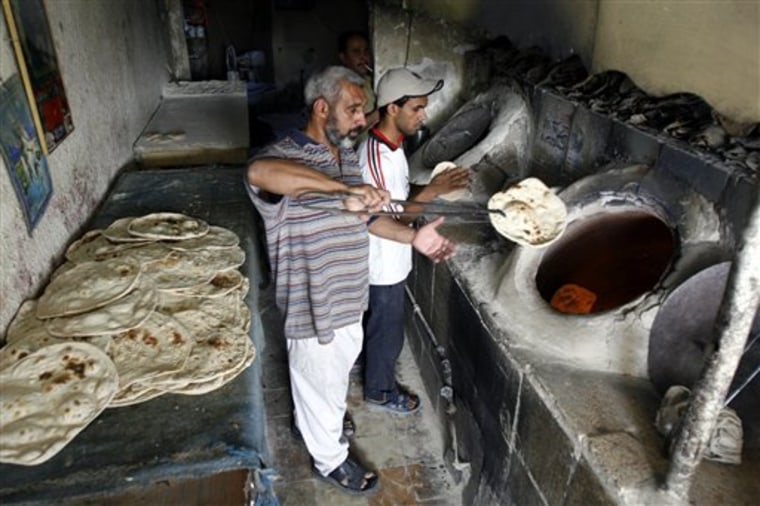In a dramatic turnaround, more than 3,000 Iraqi families driven out of their Baghdad neighborhoods have returned to their homes in the past three months as sectarian violence has dropped, the government said Saturday.
Saad al-Azawi, his wife and four children are among them. They fled to Syria six months ago, leaving behind what had become one of the capital’s more dangerous districts — west Baghdad’s largely Sunni Khadra region.
The family had been living inside a vicious and bloody turf battle between al-Qaida in Iraq and Mahdi Army militiamen. But Azawi said things began changing, becoming more peaceful, in August when radical anti-American Shiite cleric Muqtada al-Sadr ordered his Mahdi Army fighters to stand down nationwide.
About the same time, the Khadra neighborhood Awakening Council rose up against brutal al-Qaida control — the imposition of its austere interpretation of Islam, along with the murder and torture of those who would not comply.
The uprising originated in Iraq’s west and flowed into the capital. Earlier this year, the Sunni tribes and clans in the vast Anbar province began their own revolt and have successfully rid the largely desert region of al-Qaida control.
At one point the terrorist group virtually controlled Anbar, often with the complicity of the vast Sunni majority who welcomed the outsiders in their fight against American forces.
But, U.S. officials say, al-Qaida overplayed its hand with Iraq’s Sunnis, who practice a moderate version of Islam. American forces were quick to capitalize on the upheaval, welcoming former Sunni enemies as colleagues in securing what was once the most dangerous region of the country.
And as 30,000 additional U.S. forces arrived for the crackdown in Baghdad and central Iraq, the American commander, Gen. David Petraeus, began stationing many of them in neighborhood outposts. The mission was not only to take back control but to foster neighborhood groups like the one in Khadra to shake off al-Qaida’s grip.
‘It’s safe to come home’
The 40-year-old al-Azawi, who has gone back to work managing a car service, said relatives and friends persuaded him to bring his family home.
“Six months ago, I wouldn’t dare be outside, not even to stand near the garden gate by the street. Killings had become routine. I stopped going to work, I was so afraid,” he said, chatting with friends on a street in the neighborhood.
When he and his family joined the flood of Iraqi refugees to Syria the streets were empty by early afternoon, when all shops were tightly shuttered. Now the stores stay open until 10 p.m. and the U.S. military working with the neighborhood council is handing out $2,000 grants to shop owners who had closed their business. The money goes to those who agree to reopen or first-time businessmen.
Al-Azawi said he’s trying to get one of the grants to open a poultry and egg shop that his brother would run.
“In Khadra, about 15 families have returned from Syria. I’ve called friends and family still there and told them it’s safe to come home,” he said.
Sattar Nawrous, a spokesman for the Ministry of Displacement and Migration, said the al-Azawi family was among 3,100 that have returned to their homes in Baghdad in the past 90 days.
“In the past three months, the ministry did not register any forced displacement in the whole of Iraq,” said Nawrous, who is a Kurd.
The claim could not be independently verified, but, if true, it would represent a dramatic end to the sectarian cleansing that has shredded the fabric of Baghdad’s once mixed society.
Average daily death toll drops to 30
The head of the ministry is Abdul-Samad Rahman, a Shiite appointed to his job by Prime Minister Nouri al-Maliki, who is accused of promoting the Shiite cause to the detriment of Sunnis. Under Saddam Hussein, the Sunni minority ruled and heavily oppressed many in the Shiite majority.
Part of the inflow can be attributed to stiffening of visa and residency procedures for Iraqis by the Syrian government.
Mahmoud al-Zubaidi, who runs the Iraqi Airways office in Damascus, the Syrian capital, the flow of Iraqis has almost reversed.
What were once full flights arriving from Baghdad now touch down virtually empty, he told Al-Sabah, the government funded Iraqi daily newspaper. Now the flights are leaving Damascus with more passengers but the volume of travel is off considerably.
On average, 56 Iraqis — civilians and security forces — have died each day so far in this very bloody year. Last month, however, the toll fell to just under 30 Iraqis killed daily in sectarian violence.
More than four months after U.S. forces completed a 30,000-strong force buildup, the death toll for both Iraqis and Americans has fallen dramatically for two months running.
Across Iraq Saturday, 18 people were killed or found dead in sectarian violence, well below the year’s daily average.
